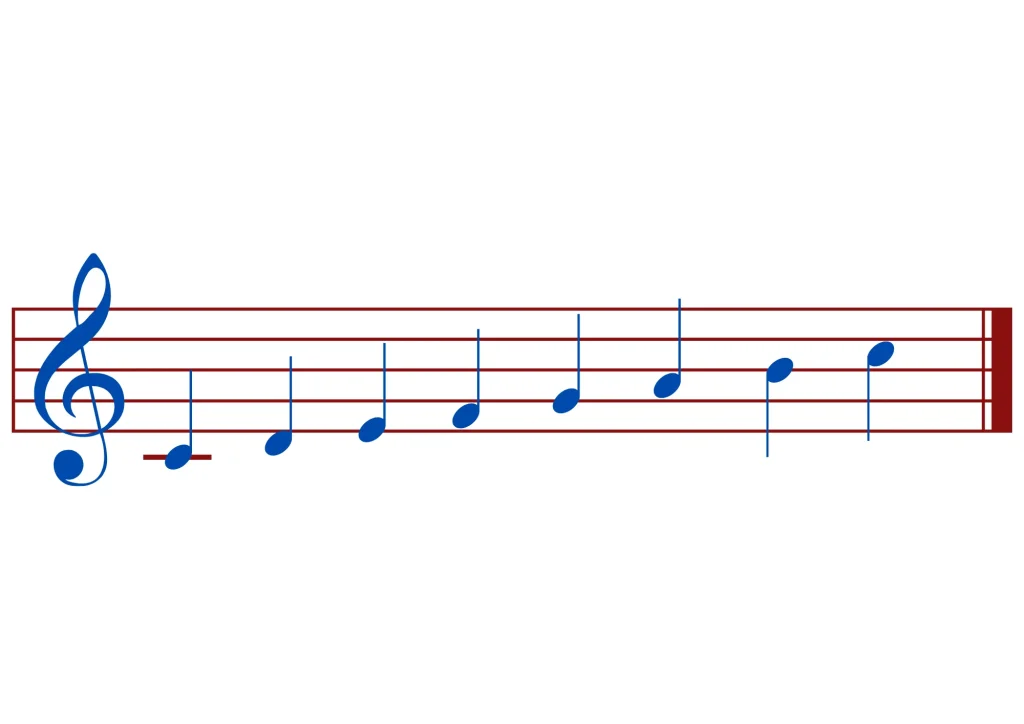- What is scale in music?
- What is the meaning of Musical Modes?
- What are the 7 modes in music?
- 1. Ionian Mode
- 2. Dorian Mode
- 3. Phrygian Mode
- 4. Lydian Mode
- 5. Mixolydian Mode
- 6. Aeolian Mode
- 7. Locrian Mode
- History of Musical Modes
- How to apply Musical Modes Scales in Singing?
- Examples of Modes of Scales in Music
- Closing Thoughts
- FAQs
If you are a beginner, you would hear the word ‘scale’ thrown around alot! So before we get into Modes of Scale in music or Major or Minor Modes, let’s begin with “What is a Scale in Music” followed by musical modes meaning and what are the 7 different modes in music.

Each time you play music, it becomes new. This is one way I’ve been thinking about memory and the present, past and future times all fitting together.
What is scale in music?
A scale in music is a bunch of musical notes in ascending or descending order with a particular interval pattern. Scales are the foundation for chords, harmonies, or any melody in music. Scales also give you an idea of the relationship between different pitches in a melody. It also comes handy when you try to read music.
Each note in a scale has an interval inserted between them. That’s what determines the sound of a scale which brings us to the different modes of scale in music. There are 7 modes of music, keep reading to learn more.

Did You Know?
The name of music Modes are Greek words and the idea of musical modes originated from ancient Greece.
What is the meaning of Musical Modes?
In simple words, modes in music are a type of scales with specific arrangement of interval patterns. These musical modes scales are made up of Whole Steps and Half Steps. Modes of a scale in music are used in a wide range of musical concepts influencing the chords, melodies and harmonies.
Modes in music have a long history in Western music that dates back to Greek musical philosophy. They came into existence throughout the Middle Ages and Renaissance, when they were essential to both religious and popular music. Music modes endured throughout the evolution of music, adjusting to different stylistic shifts and ultimately impacting genres like jazz, rock, and more.
What are the 7 modes in music?
There are 7 modes of music in major scale. Let’s now look at the different Major and Minor Music Modes.
- Ionian Mode
- Dorian Mode
- Phrygian Mode
- Lydian Mode
- Mixolydian Mode
- Aeolian Mode
- Locrian Mode
1. Ionian Mode
The Ionian music modes scale is the same as the major scale that you have learnt in the beginning of your music lessons. It begins and ends with a Tonic or the first degree of a major scale. Usually, this major music mode sounds bright and cheerful.
Formula for Ionian Modes of Scale in Music: W W H W W W H or 1 2 3 4 5 6 7 8

C D E F G A B C.
2. Dorian Mode
With reference to the major, the Dorian music modes scale starts on the second degree of a major scale. Its third degree and the sixth is reduced by a semitone and this gives it a feel of a minor scale.
Formula for Dorian Modes of Scale in Music: W W H W W H W or 1 2 b3 4 5 b6 7

D E F G A B C D
3. Phrygian Mode
The Phrygian music modes scale begins at the third degree of a major scale.
This sounds almost as if a natural minor scale except with a minor second on the second degree. Now this flattened 2nd degree gives this mode a middle eastern musical flavor. Spanish music also has influences of Phrygian Mode of scales
Formula for Phrygian Modes of scale in music : H W W W H W W or 1 b2 3 4 5 b6 7

E F G A B C D E
4. Lydian Mode
Starting from the fourth degree of a Major scale, the Lydian modes in music sounds bright and breezy. The fourth degree in this mode is raised by a semitone. You can see that lots of composers use this mode of musical scale in the movie’s background score.
Formula for Lydian Modes of scale in music : W W W H W W H or 1 2 3 #4 5 6 7

F G A B C D E F
5. Mixolydian Mode
Mixolydian music modes begins at the fifth degree of a majors scale. The seventh is flattened by a semitone and this property gives this mode a jazzy feel. Most Jazz, Blues and Folk music uses this Mixolydian Mode.
Formula for Mixolydian Modes of scale in music: W W H W W H W or 1 2 3 4 5 6 b7

G A B C D E F G
6. Aeolian Mode
Aeolian music modes is known as the natural minor scale in Music. It’s also a very commonly used Mode of Musical Scale. It begins in the sixth degree of the major scale and the third, sixth and seventh degrees are flattened by a semitone. This mode sets a sad and a sorrowful mood and is suitable for almost all the genres of music.
Formula for Aeolian Modes of scale in music: W H W W H W W or 1 2 b3 4 5 b6 b7

A B C D E F G A
7. Locrian Mode
Locrian music modes begins at the seventh degree of a major scale. This one mode is rarely used by the musicians because it sounds dissonant. The second, third, fifth, sixth and seventh degrees are flattened by a semitone and this makes it sound dark.
Formula for Locrian Modes of scale in music: H W W H W W W or 1 b2 b3 4 b5 b6 b7

B C D E F G A B
Phrygian, Aeolian, Dorian and Locrian modes are Minor modes.
History of Musical Modes
Musical modes have an important part played in Western Music Theory then and now. It has a deep impact on melodies, harmonies and other aspects of music.
So Greek music brought out the idea of modes from a concept called “Diatonic Genus,” one of the three significant musical scales of Greek music.
Christian church music used modes in the medieval times. It was used in chanting of religious prayers at the churches. Musical modes were also used in arranging melodies and harmonies in gospel music. Each mode expressed a different mood and emotions.
During the renaissance period, musical modes and cadences were commonly used in harmony arrangements.

Did You Know?
Composers like Lasso, Giovanni Pierluigi da Palestrina, and Josquin des Prez were the first ones to use the different modes in their compositions to add emotional touch.
How to apply Musical Modes Scales in Singing?
You should start by understanding the intervals between each note in each musical mode. It’s a common mistake that we think the intervals are all the same. Best way to understand the sound of each mode is to practice the similar musical modes scales This will make you familiar with the sound and therefore the mood or the emotion it sets upon. This in turn will help you identify the kind of mode used in songs. It’s tedious but trust me it’s fun!
You can also try reciprocating and later improvising the singers sing each mode in their song. Once you get a grip on how to use a musical mode in song, try writing 4 or 5 phrases and try composing a tune in the said mode. You can also experiment using different musical modes for the same set of the phrases. You will be able to feel the difference in mood and its emotions.
Examples of Modes of Scales in Music
Ionian Mode- Joy to the World or ‘Happy Birthday to you’
Dorian Mode- Scarborough Fair by Simon and Garfunkel
Phrygian Mode- ‘Whenever I May Roam’ by Metallica
Lydian Mode- Man on the Moon By R.E.M
Mixolydian Mode- Beautiful By Christina Aguilera
Aeolian Mode- White Flag by Dido
Locrian Mode- Claude Debussy’s Jeaux
Closing Thoughts
Understanding scale in music can help you add richness to your singing or to your composition. In conclusion, from happy Ionian mode to dark Locrian modes, each mode offers a wide variety of emotions and different colors. To learn such amazing concepts in music, Book a free demo with us at MUSICMASTER Today!
FAQs
How do you use modes in music composition?
You can compose a melody using the notes of a specific mode accordingly.
What are the characteristics of each musical modes scales?
Ionian Mode: Happy and bright
Dorian Mode: Sad and Gloomy
Phrygian Mode: Dark
Lydian Mode: Dreamy and breezy
Mixolydian Mode: Jazzy
Aeolian Mode: Natural minor
Locrian Mode: Dissonant
What is the Dorian music mode scale?
Dorian mode starts on the second degree of a major scale and is a minor scale that has 3rd and 6th degree raised by a semitone.
What is the Phrygian music mode scale?
Phrygian mode sounds almost as if a natural minor scale except with a minor second on the second degree.
Related blog: Easy english songs to sing































